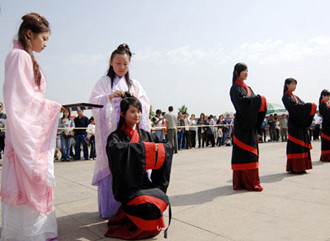(单词翻译:单击)
General Description
概述
Among the Han people,which constitute a vast majority of China's total population,the passage into adulthood is no longer celebrated,except in those very, very traditional families. In ancient times,this ceremony marked a person's transition to adulthood and was generally referred to as the capping or hair-pinning ceremony.
汉族占中国人口的绝大多数。在汉族人中,除了那些非常传统的家庭,成人礼已不再举行。在古代,这一仪式标志着一个人进入了成年阶段,通常被称为“冠礼”或“异礼”。
This ceremony started from the dan society of the long past and continued to be held until the Qing Dynasty(1644一1911).The Manchu rulers then felt that this ceremony of the Han people had become“hypocritical" and meaningless and thus mandated that this ceremony,which had lasted for thousands of years,should be abolished. From then on the Han people have to enter the stage of adulthood without knowing it. Nowadays,it is mainly in those minor ethnic groups fihat this life passage is still celebrated. In some parts of China,this ceremony is experiencing a revival.
这一礼仪始于远古的氏族社会,一直延续到清朝(1644一1911)。清朝的满族统治者感到汉族的这一礼仪已经变成了一种虚文假醋,无足轻重,于是一纸令下,终结了汉族绵延几千年的成人礼。从此后,汉族人只能在“不知不觉”中进人成年。现在,中国的成人仪式主要集中在一些少数民族。有些地方,汉族的成人礼也在渐渐复兴。
Capping and Hair-Pinning
冠礼和异礼
The capping and hair-pinning ceremony of the ancient times was originally intended to prevent non-adults from getting married and later evolved into a moral test on adults' marriage qualifications.
古代的成年礼本意是为了禁止与未成年的异性通婚。冠礼是成年礼的一种高级的代表形式,也可以说是对成年人婚姻资格的一种道德审查。
When a young man reached 18 or 20 years old,the capping ceremony would be held. It consisted of several procedures. The hair of the young man should be done up and pinned. Then three caps of different materials which carried different meanings should be placed the youth's head. This was called "Three Caps Cer emony".After this,the father or other seniors would appoint an alias to the new adult apart from his name. Only those men who had been through the“Three Caps Ceremony" and had an alias could get married in the past.
一个年轻的男人十八岁或二十岁时,要举行冠礼。冠礼的程序可以分为三部分。首先要把参加冠礼的年轻人的头发盘起替上。然后给他戴上三顶不同材质不同含义的帽子,这一礼仪叫“三加”。“三加”之后,由父亲或其他长辈在其本名之外另起一个“字”,只有“冠而字”的男子,才具备日后择偶成婚的资格。
The hair-pinning ceremony would be held when a girl was 15 years old. At the ceremony the mother or another senior did up and pinned the girl's hair. This change of hairstyle meant that the girl had reached maturity and can be wedded.
与男子的冠礼相对,女子的成年礼叫异礼,也叫加笋,在巧岁时举行,就是由女孩的母亲或长辈替她把头发盘结起来,加上一根簪子;改变发式表示从此结束少女时代,可以嫁人了。

Teeth-Painting and Tattooing
漆齿和纹身
People from the Dai and Bulang nationalities celebrate the passage into adulthood through teeth-painting and tattooing. Those without painted teeth cannot engage themselves in socialising. Before his/her teeth are painted,the child usually smears them with some acid juice. And then some pine wood is lit to smoke the teeth. This may continue for several days until the teeth are all black.
漆齿和纹身是傣族、布朗族等成人礼的组成部分。没有漆齿者不能公开参加社交活动。染齿前,需先用酸汁涂抹一遍牙齿,再点一束松明,以黑烟熏齿,连染数日,直至将雪白的牙齿染成墨黑色。
Tattooing is only for men. There is folk saying among the Dai and Bulang people,“Frogs have patterns on their legs;how can men have no tattoos on their legs" Men are proud of their tattoos;those without tattoos will be looked down upon and regarded as cowards by girls. The tattooing ceremony is usually held when the bov is fourteen or fifteen.
只有男人才会纹身。民间有谚语说:“蛙腿尚有花纹,男人之腿怎可没有花纹。”男性以纹身为荣,身上不刺纹者,会被姑娘们视为懦夫。纹身一般在十四五岁时进行。
Changing into Trousers or Skirts
换裙和换裤
The Mosuo,Naxi,Pumi and Yi nationalities celebrate their passage of life into adulthood by changing into trousers or skirts.
摩梭族、纳西族、普米族、彝族等都通过更换服饰象征成年,女的换裙,男的换裤。
When a Mosuo child reaches 13,the rite of passage into adulthood will be held. This ceremony usually takes place on the first day of the lunar new year. The boy stands beside the“male column" on the left of the main hall and the girl beside the "female column" on the right, with one foot on pork and the other on a bag of grains,which means that they will be prosperous all along their life. Then the mother dresses her girl in a skirt and the uncle dresses the boy in adult men's clothes. The rites of passage into adulthood held by the Naxi and Pumi people are similar to this.
摩梭族孩子长到13岁,便要举行成年礼。成年礼仪式一律在农历大年初一凌晨举行。行礼时,男孩站在正房左边“男柱”下,女孩站在右边“女柱”下,一只脚踩着猪膘肉,一只脚踩着粮袋,象征终生吃用不尽。女孩由阿妈为其穿上裙子。男孩由舅舅为其穿戴簇新男装。纳西族、普米族的成人礼与此相似。
Other Customs
其他风俗
There are other interesting customs concerning celebration of the passage into adulthood. For example the rite of passage into adulthood of the Jinuo people involves cattle slaying and saga-chanting. Boys of the Yao nationality have to pass about ten dangerous tests and take oaths not to conduct bad deeds. There are 56 ethnic groups in China and customs vary,it is simply impossible to discuss all of them.
关于成人礼,还有其他一些有意思的风俗。比如基诺族举行成人礼时要杀牛唱诗;瑶族的男孩要通过近十项危险的考验,而且要发誓不干坏事。中国有五十六个少数民族,要讨论所有的风俗习惯是不可能的。


